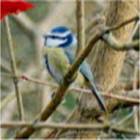
 |
 |
 |
 |
 |
What
Insects might you find in a hedge?
Birds | Butterflies | Insects | Mammals
Birds
The greater the variety of trees and plants in and around a hedge then the greater the variety of birds that you will likely find in a hedgerow.In Ireland you will find native birds, birds thqat live here all year round. You will also find birds that migrate to Ireland at different times of the year.
In this and following pages, you will find an alphabetical list of many of the birds that you might commonly find in Irish hedgerows.
| Blackbird |
 |
| About the
Blackbird: Blackbirds are 25cm in length. Male Blackbirds are jet-black with a bright yellow beak and eye-ring. Female Blackbirds have a brown plumage and a brown beak. They range across Europe including Ireland. They eat insects and worms, as well as feeding on berries and fruit. They have a loud and warbling flute-like song and a noisy chatter when disturbed. Blackbirds use a variety of nest sites including trees, bushes, hedges and buildings, or may even be seen nesting directly on the ground. |
| Blue Tit |
 |
| About the Blue Tit: Blue Tits have yellow underparts with blue wings, a blue tail and a blue cap. Adults have white cheeks, but those of the young are yellow. When they are excited, they raise the short crest on their nape. They range throughout Europe and are widespread in Ireland and the UK. Blue Tits live in deciduous woodland, parks, gardens and farmland hedges. They feed on small insects, spiders, fruits, seeds and nectar. The nest is cup-shaped and made of moss and grass and lined with hair, feathers and wool, positioned in a hole in a tree, bush, hedge or wall. |
| Bullfinch |
 |
| About the
Bullfinch: Male Bullfinch's have a black cap, black wings and tail, a white rump and wingbars, and a red breast. The female Bullfinch does not have the red breast and she is brownish-pink with a brown mantle. Bullfinches stretch from Ireland to the southern Mediterranean regions Their are usually found in coniferous forest, woodland, parks, gardens and cultivated land. They feed on buds, seeds and fruit. Bullfinches are shy birds and do not often land on the ground. They have a low whistling call as well as a quiet piping song. The female builds the very twiggy cup-shaped nest of twigs and moss in a bush or hedge. |
| Chaffinch |
 |
| About the
Chaffinch: The male Chaffinch have a slate-blue head and a wine-coloured breast and the female Chaffinch has yellow-brown plumage. Chaffinches range from Ireland through Europe, the Mediterranean region and North Africa. They are often found in woods, orchards, parks, gardens and fields with hedgerows. They mostly feed on seeds, fruit and corn, but need insect larvae for their chicks. Their call-note is a cheerful song that varies in dialect according to its region. Their nest is neat and strong and positioned in a tree or a bush close to the trunk or a firm branch. |
| Chiffchaff Warbler |
 |
| About the Chiffchaff
Warbler: The Chiffchaff Warbler is a lively bird that feeds on insects in trees and bushes. Apart from breeding time it seems to be playfully quarrelsome as it constantly chases away other birds. The Chiffchaff Warbler has a distinctive song, a repeated monotonous "chiff-chaff" or "zip-zap", sometimes interspersed with a guttural "chirr-chirr". The female bird chooses the place for the nest and builds it alone. The male bird keeps watch of the female, sings and defends the territory. The nest is ball-shaped, closed at the top and opening for flying in and out on one side.. |
| Coal Tit |
 |
| About the Coal Tit: Irish Coal Tits are easily recognised by the strong deep yellow tones on the cheeks, breast and belly. They are olive-grey above, with a glossy black head and bib and they have two faint wingbars. They often live in coniferous woodland and especially near spruce trees. They are frequently seen in parks and gardens, especially during winter. Coal Tits like to eat larval insects and spiders, often found in conifer branches, needles, and bark. They will hang upside down in trees, bushes and hedges,etc. to extract insects or seeds. Their favourite song is a high-pitched, repetitive 'wheat-see, wheat-see'. |